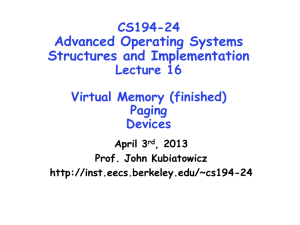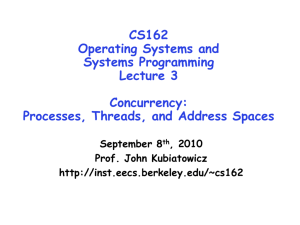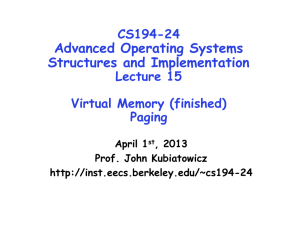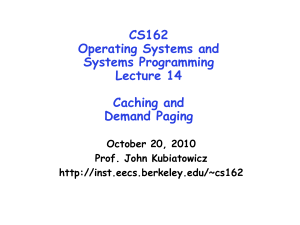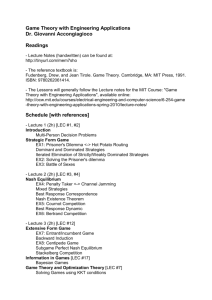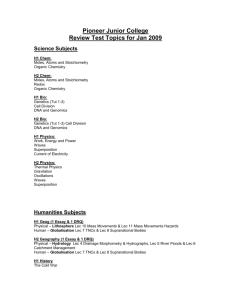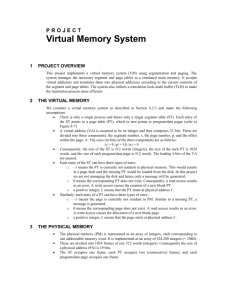CS162 Operating Systems and Systems Programming Lecture 15
advertisement
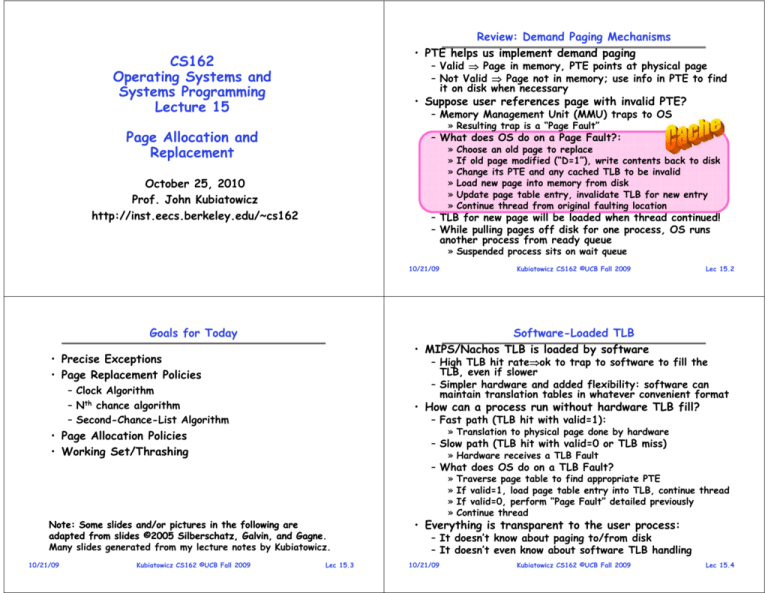
Review: Demand Paging Mechanisms • PTE helps us implement demand paging CS162 Operating Systems and Systems Programming Lecture 15 – Valid Page in memory, PTE points at physical page – Not Valid Page not in memory; use info in PTE to find it on disk when necessary • Suppose user references page with invalid PTE? – Memory Management Unit (MMU) traps to OS » Resulting trap is a “Page Fault” Page Allocation and Replacement – What does OS do on a Page Fault?: » » » » » » October 25, 2010 Prof. John Kubiatowicz http://inst.eecs.berkeley.edu/~cs162 Choose an old page to replace If old page modified (“D=1”), write contents back to disk Change its PTE and any cached TLB to be invalid Load new page into memory from disk Update page table entry, invalidate TLB for new entry Continue thread from original faulting location – TLB for new page will be loaded when thread continued! – While pulling pages off disk for one process, OS runs another process from ready queue » Suspended process sits on wait queue 10/21/09 Goals for Today Kubiatowicz CS162 ©UCB Fall 2009 Lec 15.2 Software-Loaded TLB • MIPS/Nachos TLB is loaded by software • Precise Exceptions • Page Replacement Policies – High TLB hit rateok to trap to software to fill the TLB, even if slower – Simpler hardware and added flexibility: software can maintain translation tables in whatever convenient format – Clock Algorithm – Nth chance algorithm – Second-Chance-List Algorithm • How can a process run without hardware TLB fill? – Fast path (TLB hit with valid=1): » Translation to physical page done by hardware • Page Allocation Policies • Working Set/Thrashing – Slow path (TLB hit with valid=0 or TLB miss) » Hardware receives a TLB Fault – What does OS do on a TLB Fault? Note: Some slides and/or pictures in the following are adapted from slides ©2005 Silberschatz, Galvin, and Gagne Gagne. Many slides generated from my lecture notes by Kubiatowicz. 10/21/09 Kubiatowicz CS162 ©UCB Fall 2009 Lec 15.3 » » » » Traverse page table to find appropriate PTE If valid=1, load page table entry into TLB, continue thread If valid=0, perform “Page Fault” detailed previously Continue thread • Everything is transparent to the user process: – It doesn’t know about paging to/from disk – It doesn’t even know about software TLB handling 10/21/09 Kubiatowicz CS162 ©UCB Fall 2009 Lec 15.4 OS Load TLB Consider weird things that can happen • What if an instruction has side effects? Faulting Inst 2 Faulting Inst 2 TLB Faults Faulting Inst 1 User Faulting Inst 1 Transparent Exceptions – Options: » Unwind side-effects (easy to restart) » Finish off side-effects (messy!) – Example 1: mov (sp)+,10 » What if page fault occurs when write to stack pointer? » Did sp get incremented before or after the page fault? Fetch page/ Load TLB • How to transparently restart faulting instructions? – Example 2: strcpy (r1), (r2) » Source and destination overlap: can’t unwind in principle! » IBM S/370 and VAX solution: execute twice – once read-only – Could we just skip it? » No: need to perform load or store after reconnecting physical page • What about “RISC” processors? – For instance delayed branches? • Hardware must help out by saving: » Example: bne somewhere ld r1,(sp) » Precise exception state consists of two PCs: PC and nPC – Faulting instruction and partial state » Need to know which instruction caused fault » Is single PC sufficient to identify faulting position???? – Processor State: sufficient to restart user thread – Delayed exceptions: » Example: div r1, r2, r3 ld r1, (sp) » What if takes many cycles to discover divide by zero, but load has already caused page fault? » Save/restore registers, stack, etc • What if an instruction has side-effects? 10/21/09 Kubiatowicz CS162 ©UCB Fall 2009 Lec 15.5 10/21/09 Precise Exceptions Kubiatowicz CS162 ©UCB Fall 2009 Lec 15.6 Steps in Handling a Page Fault • Precise state of the machine is preserved as if program executed up to the offending instruction – All previous instructions completed – Offending instruction and all following instructions act as if they have not even started – Same system code will work on different implementations – Difficult in the presence of pipelining, out-of-order execution, ... – MIPS takes this position • Imprecise system software has to figure out what is where and put it all back together • Performance goals often lead designers to forsake precise interrupts – system software developers, user, markets etc. usually wish they had not done this • Modern techniques for out-of-order execution and branch prediction help implement precise interrupts 10/21/09 Kubiatowicz CS162 ©UCB Fall 2009 Lec 15.7 10/21/09 Kubiatowicz CS162 ©UCB Fall 2009 Lec 15.8 Demand Paging Example • Since Demand Paging like caching, can compute average access time! (“Effective Access Time”) What Factors Lead to Misses? • Compulsory Misses: – EAT = Hit Rate x Hit Time + Miss Rate x Miss Time – EAT = Hit Time + Miss Rate x Miss Penalty • Example: – – – – Memory access time = 200 nanoseconds Average page-fault service time = 8 milliseconds Suppose p = Probability of miss, 1-p = Probably of hit Then, we can compute EAT as follows: EAT = 200ns + p x 8 ms = 200ns + p x 8,000,000ns • If one access out of 1,000 causes a page fault, then EAT = 8.2 μs: – This is a slowdown by a factor of 40! Lec 15.9 Page Replacement Policies • Why do we care about Replacement Policy? » The cost of being wrong is high: must go to disk » Must keep important pages in memory, not toss them out • FIFO (First In, First Out) – Throw out oldest page. Be fair – let every page live in memory for same amount of time. – Bad, because throws out heavily used pages instead of infrequently used pages • MIN (Minimum): – Replace page that won’t be used for the longest time – Great, but can’t really know future… – Makes good comparison case, however • RANDOM: – Pick random page for every replacement – Typical solution for TLB’s. Simple hardware – Pretty unpredictable – makes it hard to make real-time guarantees Kubiatowicz CS162 ©UCB Fall 2009 – Not enough memory. Must somehow increase size. – Can we do this? » One option: Increase amount of DRAM (not quick fix!) » Another option: If multiple processes in memory: adjust percentage of memory allocated to each one! • Conflict Misses: – Technically, conflict misses don’t exist in virtual memory, since it is a “fully-associative” cache 10/21/09 Kubiatowicz CS162 ©UCB Fall 2009 Lec 15.10 Replacement Policies (Con’t) • LRU (Least Recently Used): – Replacement is an issue with any cache – Particularly important with pages 10/21/09 • Capacity Misses: – Caused when pages were in memory, but kicked out prematurely because of the replacement policy – How to fix? Better replacement policy – 200ns x 1.1 < EAT p < 2.5 x 10-6 – This is about 1 page fault in 400000! Kubiatowicz CS162 ©UCB Fall 2009 » Prefetching: loading them into memory before needed » Need to predict future somehow! More later. • Policy Misses: • What if want slowdown by less than 10%? 10/21/09 – Pages that have never been paged into memory before – How might we remove these misses? Lec 15.11 – Replace page that hasn’t been used for the longest time – Programs have locality, so if something not used for a while, unlikely to be used in the near future. – Seems like LRU should be a good approximation to MIN. • How to implement LRU? Use a list! Head Page 6 Page 7 Page 1 Page 2 Tail (LRU) – On each use, remove page from list and place at head – LRU page is at tail • Problems with this scheme for paging? – Need to know immediately when each page used so that can change position in list… – Many instructions for each hardware access • In practice, people approximate LRU (more later) 10/21/09 Kubiatowicz CS162 ©UCB Fall 2009 Lec 15.12 Administrivia Example: FIFO • Still Grading Midterms • Suppose we have 3 page frames, 4 virtual pages, and following reference stream: – Hope to hand them out in section on Friday – Solutions have been posted –A B C A B D A D B C B • Consider FIFO Page replacement: » Just go to handouts page • Would you like an extra 5% for your course grade? – Attend lectures and sections! 5% of grade is participation • Second Midterm? – Would have to be either Monday or Wednesday after Thanksgiving (11/29 or 12/01). – I am currently seeing if there is a room available. Ref: Page: A 1 A – Due by Tomorrow at midnight – Good Luck! Kubiatowicz CS162 ©UCB Fall 2009 Lec 15.13 Example: MIN –A B C A B D A D B C B • Consider MIN Page replacement: 1 A 2 3 C A B D A D B C B D B C B C A B Kubiatowicz CS162 ©UCB Fall 2009 Lec 15.14 Ref: Page: A 1 A B C D A B D B C D A C A C B C D B D B C A D – Every reference is a page fault! • MIN Does much better: D • What will LRU do? – Same decisions as MIN here, but won’t always be true! Kubiatowicz CS162 ©UCB Fall 2009 10/21/09 3 B – MIN: 5 faults – Where will D be brought in? Look for page not referenced farthest in future. 10/21/09 A C 2 C C D When will LRU perform badly? • Consider the following: A B C D A B C D A B C D • LRU Performs as follows (same as FIFO here): • Suppose we have the same reference stream: B B – FIFO: 7 faults. – When referencing D, replacing A is bad choice, since need A again right away • Project II A A B 3 – Please use to give feedback on course – Soon: We will have a survey to fill out Ref: Page: C D 2 • We have an anonymous feedback link on the course homepage 10/21/09 B Lec 15.15 Ref: Page: A 1 A 2 3 10/21/09 B C D A B C D A B C D B B C C D Kubiatowicz CS162 ©UCB Fall 2009 Lec 15.16 Graph of Page Faults Versus The Number of Frames Adding Memory Doesn’t Always Help Fault Rate • Does adding memory reduce number of page faults? – Yes for LRU and MIN – Not necessarily for FIFO! (Called Belady’s anomaly) Ref: Page: 1 A B A 2 B – Does this always happen? – Seems like it should, right? 4 – Certain replacement algorithms (FIFO) don’t have this obvious property! Kubiatowicz CS162 ©UCB Fall 2009 A B B E A Lec 15.17 B A C C E C B D D E A B A D E A B C E B D E D A C E B D C • After adding memory: • No: BeLady’s anomaly 10/21/09 3 A C Ref: Page: 1 2 D D 3 • One desirable property: When you add memory the miss rate goes down C – With FIFO, contents can be completely different – In contrast, with LRU or MIN, contents of memory with X pages are a subset of contents with X+1 Page 10/21/09 Kubiatowicz CS162 ©UCB Fall 2009 Lec 15.18 Clock Algorithm: Not Recently Used Implementing LRU • Perfect: Single Clock Hand: Advances only on page fault! Check for pages not used recently Mark pages as not used recently – Timestamp page on each reference – Keep list of pages ordered by time of reference – Too expensive to implement in reality for many reasons • Clock Algorithm: Arrange physical pages in circle with single clock hand Set of all pages in Memory – Approximate LRU (approx to approx to MIN) – Replace an old page, not the oldest page • Details: – Hardware “use” bit per physical page: » Hardware sets use bit on each reference » If use bit isn’t set, means not referenced in a long time » Nachos hardware sets use bit in the TLB; you have to copy this back to page table when TLB entry gets replaced – On page fault: » Advance clock hand (not real time) » Check use bit: 1used recently; clear and leave alone 0selected candidate for replacement – Will always find a page or loop forever? » Even if all use bits set, will eventually loop aroundFIFO 10/21/09 Kubiatowicz CS162 ©UCB Fall 2009 Lec 15.19 • What if hand moving slowly? – Good sign or bad sign? » Not many page faults and/or find page quickly • What if hand is moving quickly? – Lots of page faults and/or lots of reference bits set • One way to view clock algorithm: – Crude partitioning of pages into two groups: young and old – Why not partition into more than 2 groups? 10/21/09 Kubiatowicz CS162 ©UCB Fall 2009 Lec 15.20 • Nth Nth Chance version of Clock Algorithm chance algorithm: Give page N chances Clock Algorithms: Details • Which bits of a PTE entry are useful to us? – OS keeps counter per page: # sweeps – On page fault, OS checks use bit: » 1clear use and also clear counter (used in last sweep) » 0increment counter; if count=N, replace page – Means that clock hand has to sweep by N times without page being used before page is replaced • How do we pick N? – Why pick large N? Better approx to LRU – Use: Set when page is referenced; cleared by clock algorithm – Modified: set when page is modified, cleared when page written to disk – Valid: ok for program to reference this page – Read-only: ok for program to read page, but not modify » For example for catching modifications to code pages! » If N ~ 1K, really good approximation • Do we really need hardware-supported “modified” bit? – Why pick small N? More efficient » Otherwise might have to look a long way to find free page – No. Can emulate it (BSD Unix) using read-only bit » Initially, mark all pages as read-only, even data pages » On write, trap to OS. OS sets software “modified” bit, and marks page as read-write. » Whenever page comes back in from disk, mark read-only • What about dirty pages? – Takes extra overhead to replace a dirty page, so give dirty pages an extra chance before replacing? – Common approach: » Clean pages, use N=1 » Dirty pages, use N=2 (and write back to disk when N=1) 10/21/09 Kubiatowicz CS162 ©UCB Fall 2009 Lec 15.21 10/21/09 Clock Algorithms Details (continued) – No. Can emulate it similar to above: » Mark all pages as invalid, even if in memory » On read to invalid page, trap to OS » OS sets use bit, and marks page read-only – Get modified bit in same way as previous: » On write, trap to OS (either invalid or read-only) » Set use and modified bits, mark page read-write LRU victim Directly Mapped Pages Second Chance List Marked: RW List: FIFO Marked: Invalid List: LRU Page-in From disk – When clock hand passes by, reset use and modified bits and mark page as invalid again • Remember, however, that clock is just an approximation of LRU – Can we do a better approximation, given that we have to take page faults on some reads and writes to collect use information? – Need to identify an old page, not oldest page! – Answer: second chance list Kubiatowicz CS162 ©UCB Fall 2009 Lec 15.22 Second-Chance List Algorithm (VAX/VMS) • Do we really need a hardware-supported “use” bit? 10/21/09 Kubiatowicz CS162 ©UCB Fall 2009 Lec 15.23 New Active Pages New SC Victims • Split memory in two: Active list (RW), SC list (Invalid) • Access pages in Active list at full speed • Otherwise, Page Fault – Always move overflow page from end of Active list to front of Second-chance list (SC) and mark invalid – Desired Page On SC List: move to front of Active list, mark RW – Not on SC list: page in to front of Active list, mark RW; page out LRU victim at end of SC list 10/21/09 Kubiatowicz CS162 ©UCB Fall 2009 Lec 15.24 Free List Second-Chance List Algorithm (con’t) • How many pages for second chance list? Single Clock Hand: Advances as needed to keep freelist full (“background”) – If 0 FIFO – If all LRU, but page fault on every page reference • Pick intermediate value. Result is: Set of all pages in Memory – Pro: Few disk accesses (page only goes to disk if unused for a long time) – Con: Increased overhead trapping to OS (software / hardware tradeoff) • With page translation, we can adapt to any kind of access the program makes – Later, we will show how to use page translation / protection to share memory between threads on widely separated machines • Question: why didn’t VAX include “use” bit? – Strecker (architect) asked OS people, they said they didn’t need it, so didn’t implement it – He later got blamed, but VAX did OK anyway 10/21/09 Kubiatowicz CS162 ©UCB Fall 2009 Lec 15.25 Demand Paging (more details) D D Free Pages For Processes • Keep set of free pages ready for use in demand paging – Freelist filled in background by Clock algorithm or other technique (“Pageout demon”) – Dirty pages start copying back to disk when enter list • Like VAX second-chance list – If page needed before reused, just return to active set • Advantage: Faster for page fault – Can always use page (or pages) immediately on fault 10/21/09 Kubiatowicz CS162 ©UCB Fall 2009 Lec 15.26 Summary • Precise Exception specifies a single instruction for which: • Does software-loaded TLB need use bit? Two Options: – Hardware sets use bit in TLB; when TLB entry is replaced, software copies use bit back to page table – Software manages TLB entries as FIFO list; everything not in TLB is Second-Chance list, managed as strict LRU • Core Map – Page tables map virtual page physical page – Do we need a reverse mapping (i.e. physical page virtual page)? » Yes. Clock algorithm runs through page frames. If sharing, then multiple virtual-pages per physical page » Can’t push page out to disk without invalidating all PTEs – All previous instructions have completed (committed state) – No following instructions nor actual instruction have started • Replacement policies – FIFO: Place pages on queue, replace page at end – MIN: Replace page that will be used farthest in future – LRU: Replace page used farthest in past • Clock Algorithm: Approximation to LRU – Arrange all pages in circular list – Sweep through them, marking as not “in use” – If page not “in use” for one pass, than can replace • Nth-chance clock algorithm: Another approx LRU – Give pages multiple passes of clock hand before replacing • Second-Chance List algorithm: Yet another approx LRU – Divide pages into two groups, one of which is truly LRU and managed on page faults. 10/21/09 Kubiatowicz CS162 ©UCB Fall 2009 Lec 15.27 10/21/09 Kubiatowicz CS162 ©UCB Fall 2009 Lec 15.28

